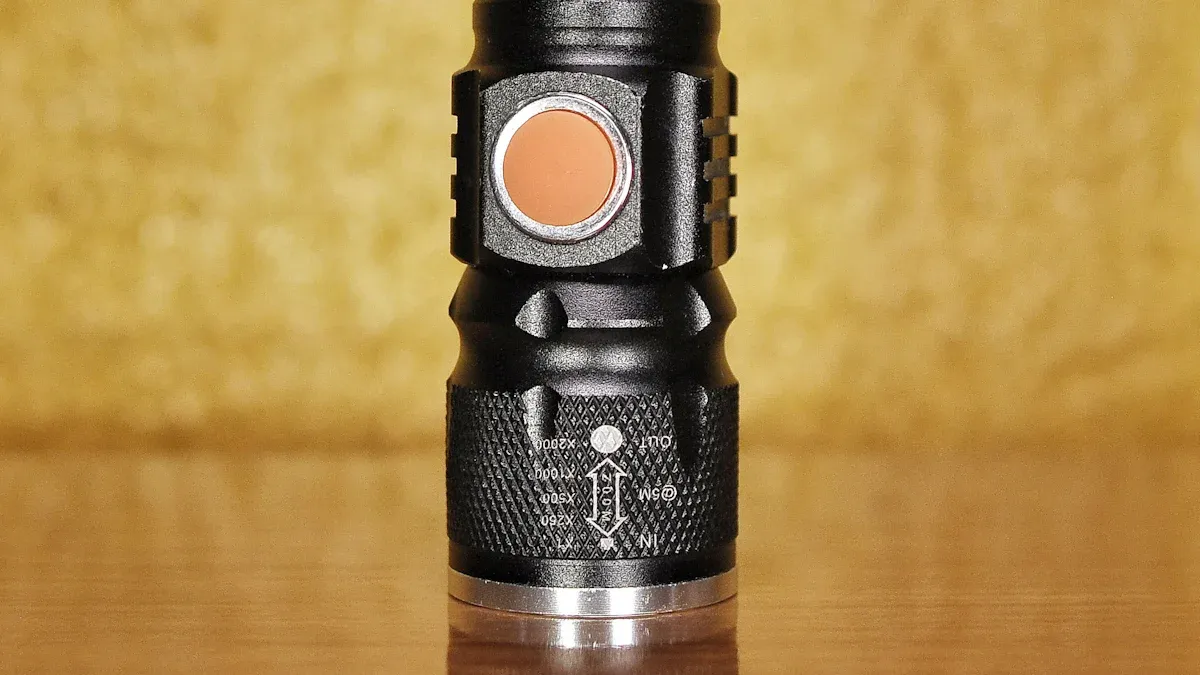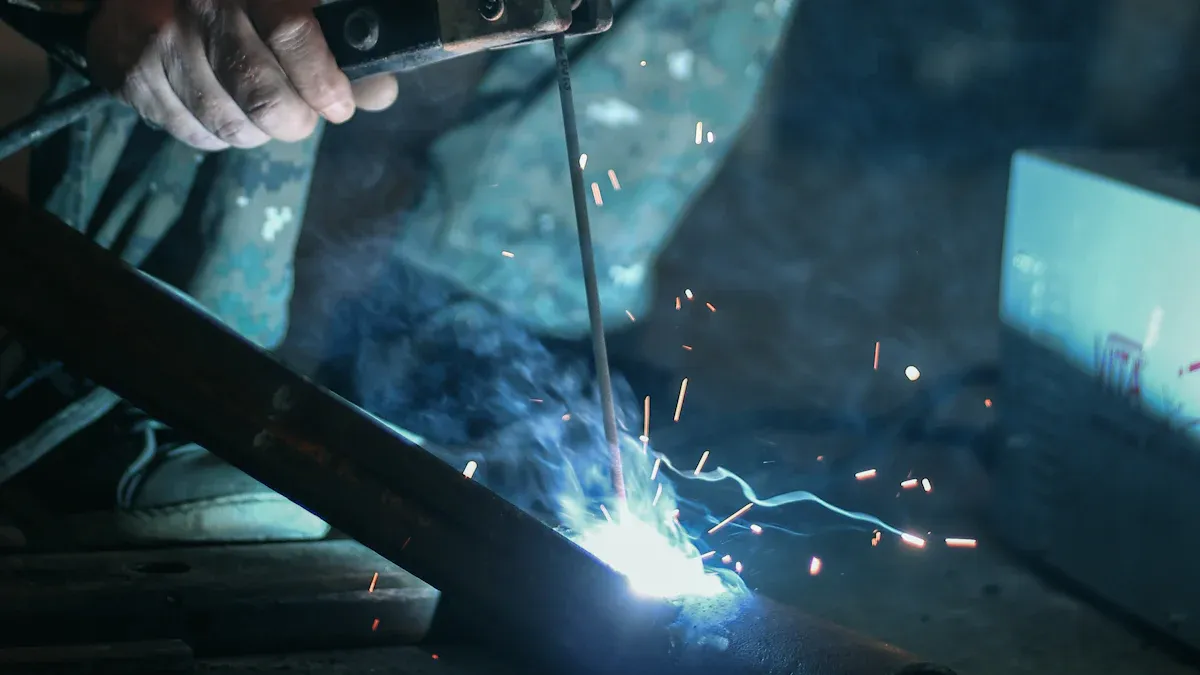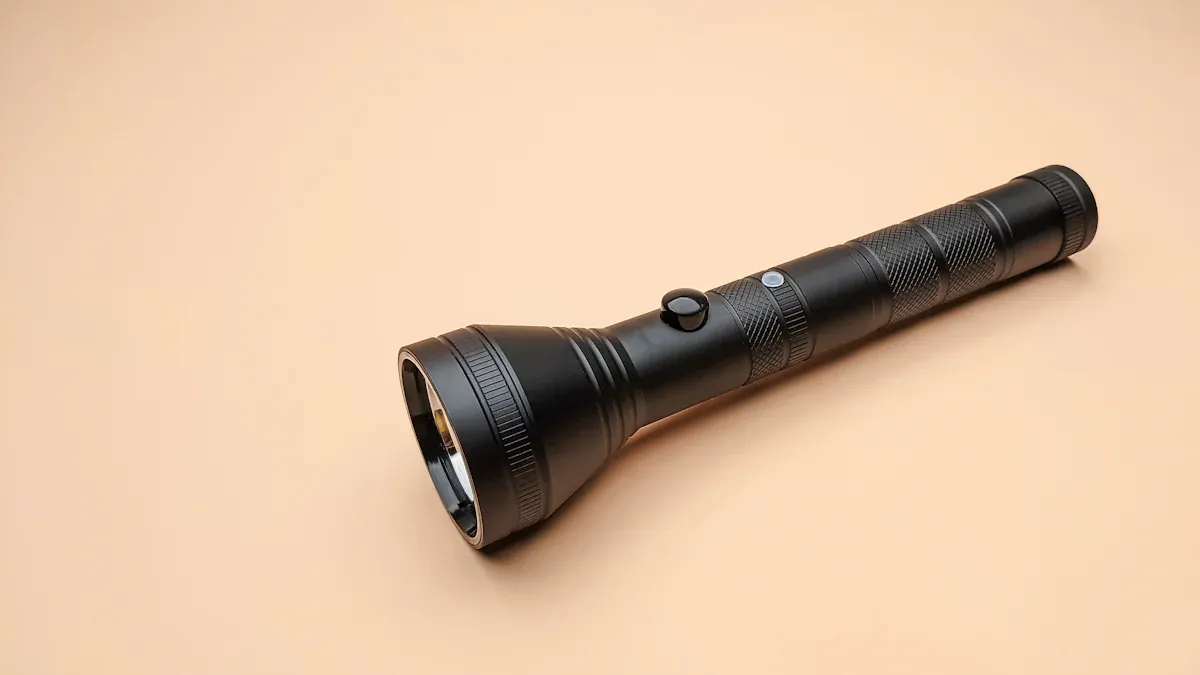Protecting Your Flashlight from Extreme Weather Conditions

Your flashlight is a vital tool during severe weather. Protecting it ensures it works when you need it most. Proper maintenance extends its lifespan by preventing damage. For example:
Water resistance stops moisture from causing harm.
Battery care keeps performance reliable.
Regular cleaning avoids dirt buildup.
Safe storage shields it from environmental risks.
Investing in a durable option, like the helius flashlight, prepares you for emergencies.
Key Takeaways
Make your flashlight waterproof to stop water damage in storms. Choose ones with rubber seals and O-rings for good protection.
Keep your flashlight in a cool, dry spot to stop overheating or battery leaks in hot weather. Pick heat-safe materials for extra strength.
Use batteries that work in the cold so your flashlight works in freezing weather. Try lithium-ion or special cold-weather batteries.
Protecting Your Flashlight During Thunderstorms

Waterproofing Your Flashlight
Thunderstorms often bring heavy rain, making waterproofing essential for flashlight protection. A high-quality waterproof flashlight with tightly sealed casings can prevent water from damaging internal components. Look for models with rubber gaskets and O-rings, as these elements block water ingress effectively. Materials like anodized aluminum or stainless steel resist corrosion, ensuring durability in wet conditions. Waterproofing not only maintains visibility during storms but also extends the lifespan of your flashlight. This feature proves invaluable during activities like camping, boating, or emergency preparedness when severe weather strikes.
Preventing Electrical Damage
Electrical surges during thunderstorms can harm your flashlight. To avoid this, store your flashlight away from power sources or areas prone to lightning strikes. If you use a rechargeable flashlight, unplug it during a weather warning to prevent damage from a power surge. Opt for flashlights with surge-resistant circuits for added protection. These precautions ensure your flashlight remains functional when you need it most, especially during emergencies caused by storms.
Ensuring Accessibility During Power Outages
Power outages are common during thunderstorms, so keeping your flashlight accessible is crucial. Store it in a designated spot where you can easily find it in the dark. Regularly check and replace its batteries to ensure it works when needed. Consider adding flashlights to your emergency kit alongside extra batteries and supplies. Smartphone apps that turn your phone’s LED flash into a light source can serve as a backup. These steps help you stay prepared for an emergency and ensure you have reliable lighting during outages.
Keeping Your Flashlight Safe in Hurricanes
Using a Helius Flashlight for Durability
Hurricanes test the durability of your tools, and the Helius flashlight stands out as a reliable choice. Its robust construction ensures it performs well in extreme weather. Built from titanium, it offers an excellent strength-to-weight ratio, making it both lightweight and tough. This flashlight resists accidental drops and bumps, which is crucial during storms. Users praise its ability to remain intact in harsh conditions, providing consistent illumination when you need it most. Choosing a durable flashlight like the Helius flashlight enhances your hurricane preparedness and ensures reliable protection against severe weather challenges.
Storing Flashlights in a Secure, Dry Location
Proper storage is essential to protect your flashlight during hurricanes. Keep it in a dry, cool place to prevent moisture buildup, which can damage internal components. A protective case adds an extra layer of safety, shielding your flashlight from impacts and scratches during transport. Place your flashlight in an easily accessible location so you can grab it quickly during an emergency. These simple steps ensure your flashlight remains functional and ready to use when a storm warning arises.
Preparing Backup Batteries and Supplies
Backup batteries are vital for maintaining your flashlight’s functionality during hurricanes. Stock up on high-quality batteries and store them in a waterproof container to keep them safe from moisture. Rechargeable batteries can also be a good option, but ensure they are fully charged before a storm hits. Include extra supplies like a battery tester and a portable charger in your emergency kit. These preparations guarantee your flashlight stays operational throughout the storm, providing reliable protection and peace of mind.
Maintaining Flashlight Functionality in Heatwaves
Avoiding Overheating and Battery Leaks
Heatwaves can cause flashlights to overheat, leading to battery leaks or damage to internal components. To prevent this, avoid leaving your flashlight in direct sunlight or inside a hot car. High temperatures can degrade battery performance and increase the risk of leaks. Use flashlights with built-in thermal protection to regulate heat and maintain functionality. Regularly inspect your flashlight for signs of battery corrosion or swelling. If you notice any issues, replace the batteries immediately to ensure safety and reliability during an emergency.
Choosing Heat-Resistant Flashlights
Not all flashlights are designed to withstand extreme heat. When preparing for heatwaves, choose a flashlight made from heat-resistant materials like aluminum or polycarbonate. These materials can endure high temperatures without warping or melting. Look for models with advanced heat dissipation features, such as vented designs or heat sinks, which help keep the flashlight cool during extended use. A durable, heat-resistant flashlight ensures reliable protection against severe weather and keeps you prepared for unexpected situations.
Proper Storage to Prevent Heat Damage
Proper storage plays a crucial role in protecting your flashlight during heatwaves. Follow these best practices:
Store your flashlight in a cool, dry place to avoid exposure to extreme temperatures.
Keep it dry to prevent moisture from affecting the batteries or internal circuitry.
Avoid placing your flashlight near heat sources like stoves or generators. A protective case can also shield it from environmental damage. These steps ensure your flashlight remains functional and ready for use when a storm or heatwave warning arises.
Protecting Your Flashlight in Freezing Temperatures

Using Cold-Resistant Batteries
Freezing temperatures can severely impact your flashlight’s performance. Standard batteries often struggle in extreme cold, leading to reduced runtime or complete failure. Lithium-ion batteries, while better than traditional options, may still experience slowed chemical reactions in subzero conditions. For reliable performance, consider using cold-weather batteries like City Labs' NanoTritium™, which are specifically designed to function in extreme weather. Always carry extra batteries in a waterproof container to ensure you’re prepared for an emergency. This simple step guarantees your flashlight remains operational, even during the harshest winter storms.
Preventing Condensation and Moisture Build-Up
Condensation inside your flashlight can lead to electrical failures, especially in freezing weather. To prevent this, choose a plastic flashlight, as it doesn’t draw heat away from your hand like metal models. Using gloves can also stop the flashlight from freezing to your skin. Ensure all internal contacts are made of the same metal to maintain proper connections in the cold. Opt for LED bulbs instead of traditional ones, as LEDs are less likely to break due to temperature differences. These precautions provide essential protection for your flashlight, keeping it functional when you need it most.
Insulating Your Flashlight for Optimal Performance
Insulation is key to maintaining your flashlight’s performance in freezing conditions. Plastic flashlights are ideal because they retain heat better than metal ones. If you use a metal flashlight, ensure it has uniform metal contacts to avoid poor connections caused by uneven contraction in the cold. Wrapping your flashlight in insulating materials, such as foam or rubber, can also help. Additionally, LED bulbs are more reliable in extreme weather, as they resist breakage from sudden temperature changes. These techniques ensure your flashlight stays operational, even during prolonged exposure to freezing temperatures.
Protecting your flashlight during severe weather ensures it remains reliable when you need it most. Regular cleaning, proper storage, and battery care are essential steps to maintain functionality. Durable options like the Helius flashlight offer exceptional protection with features like titanium construction and powerful illumination. To enhance severe weather safety, store flashlights in accessible locations, test them monthly, and keep extras in your emergency kit. These proactive measures help protect your home and ensure you’re prepared for emergencies.
FAQ
What should you include in your disaster supply kit for flashlight maintenance?
Pack extra batteries, a battery tester, and a waterproof container. These items ensure your flashlight remains functional during emergencies like floods or outages.
How can you protect your flashlight from power surges during storms?
Unplug rechargeable flashlights during storms. Store them away from electrical outlets. A lightning protection system can also safeguard your emergency equipment from damage.
What are some electrical safety tips for flashlight storage?
Keep flashlights in dry, secure locations. Avoid placing them near heat sources or damp areas. Proper storage helps protect your property and ensures flashlight reliability.
See Also
Key Strategies for Properly Maintaining Your Flashlight
Designed for Longevity: Our Reliable Emergency Flashlight
Maximize Your Flashlight's Lifespan for Extended Usage
